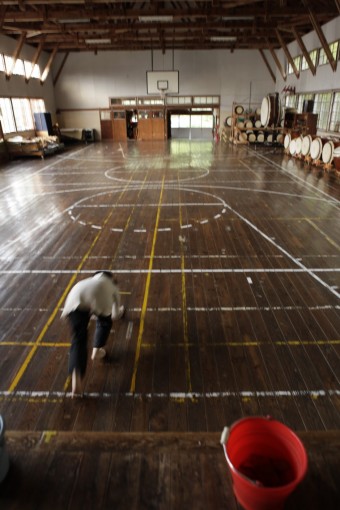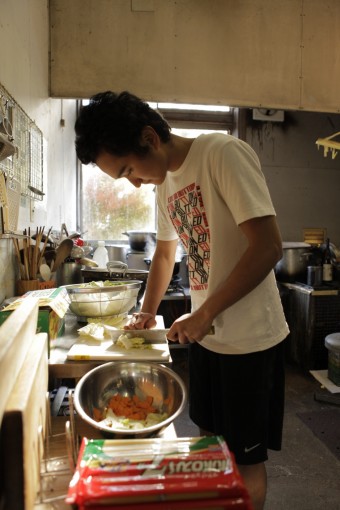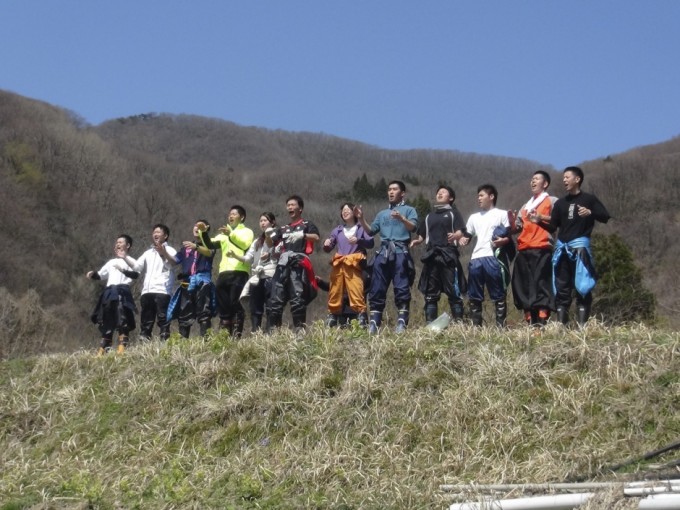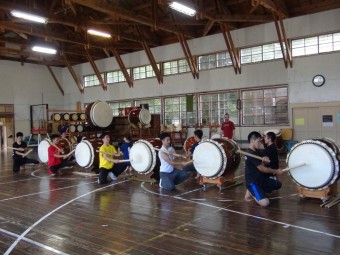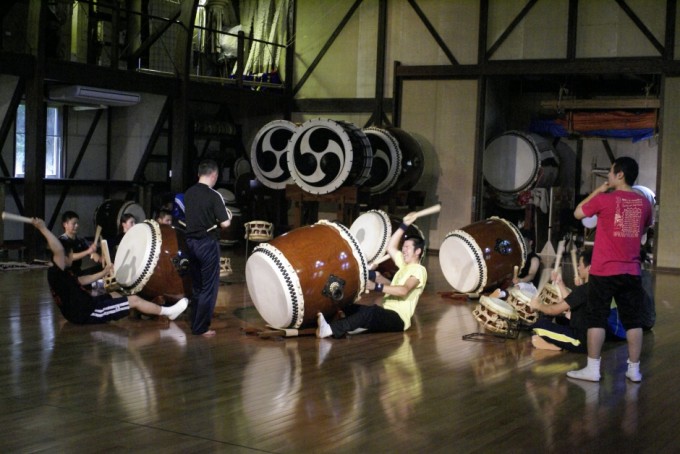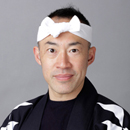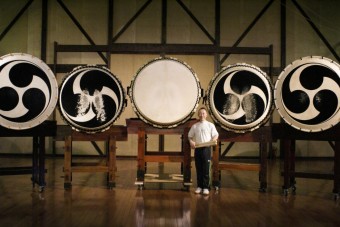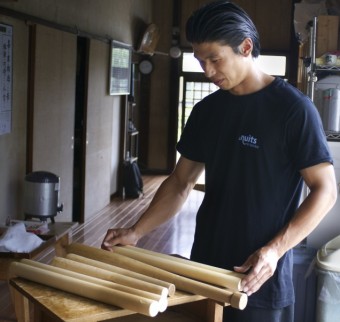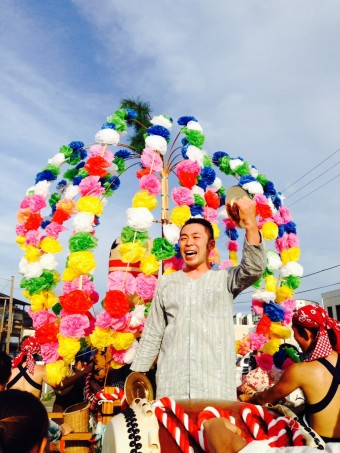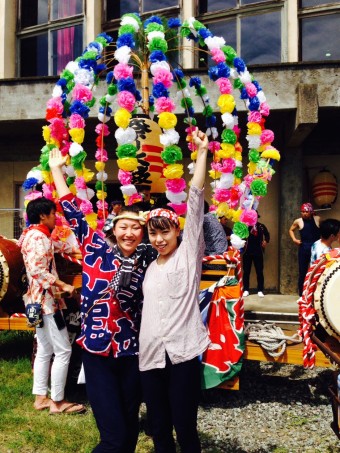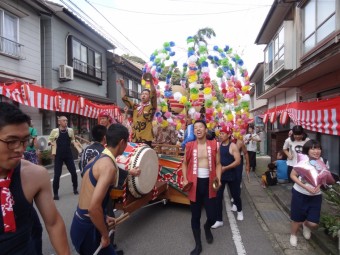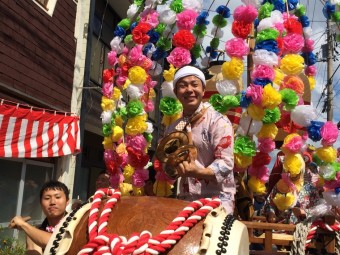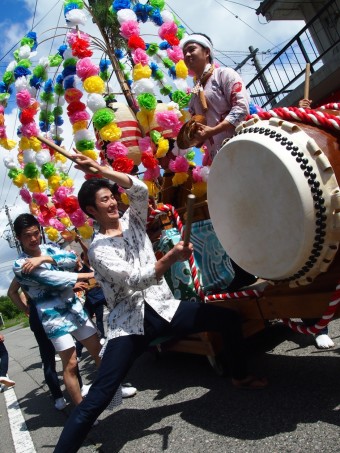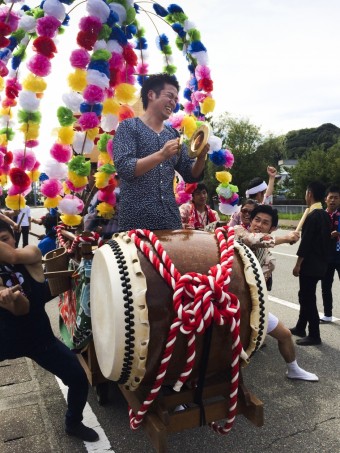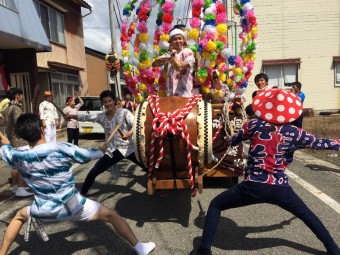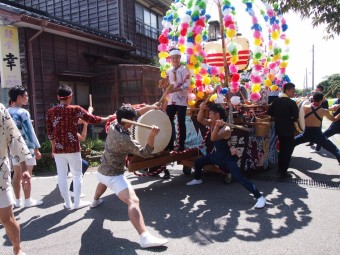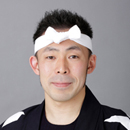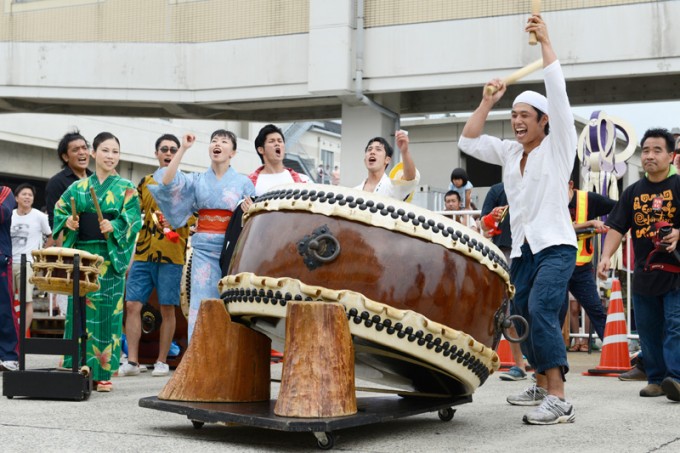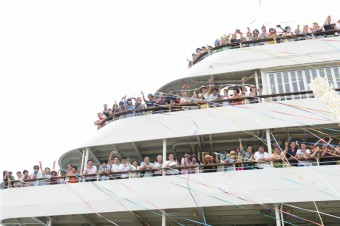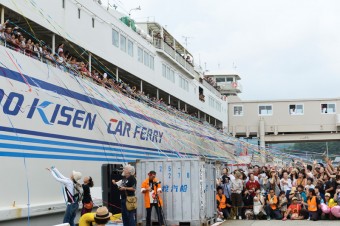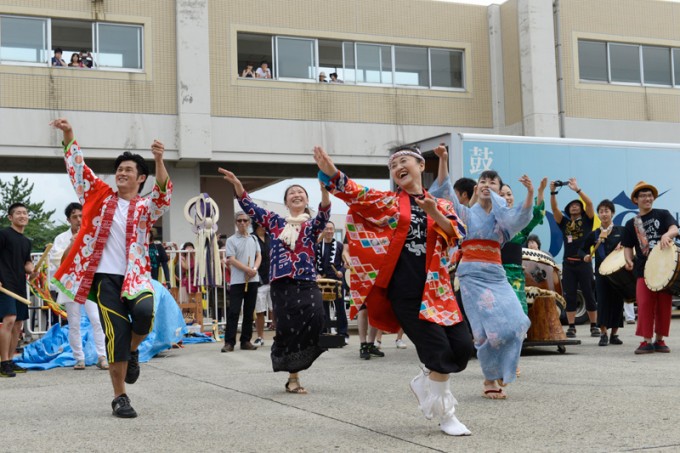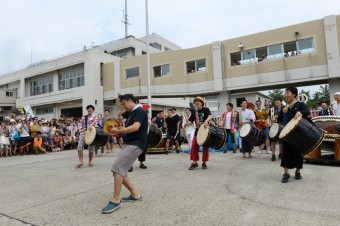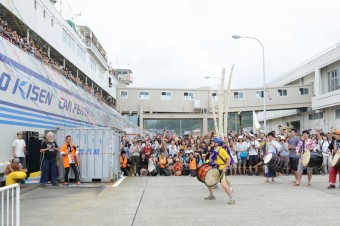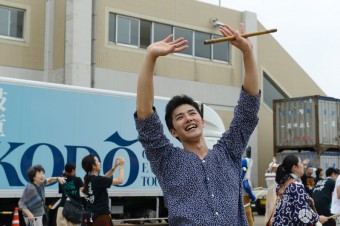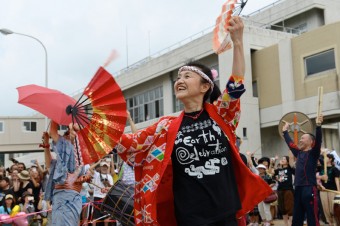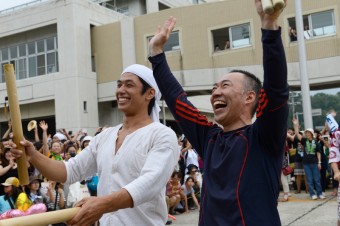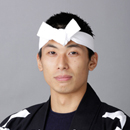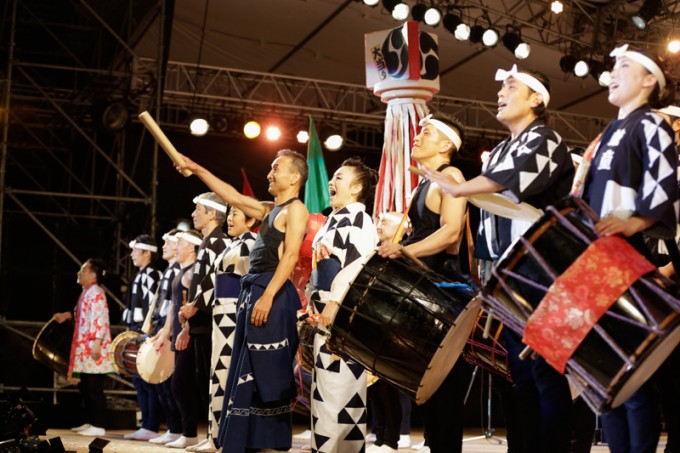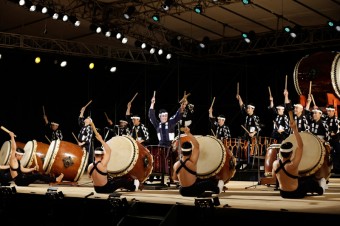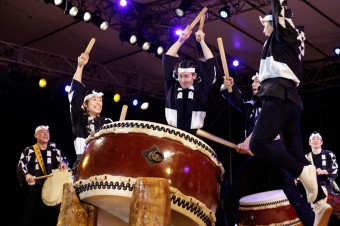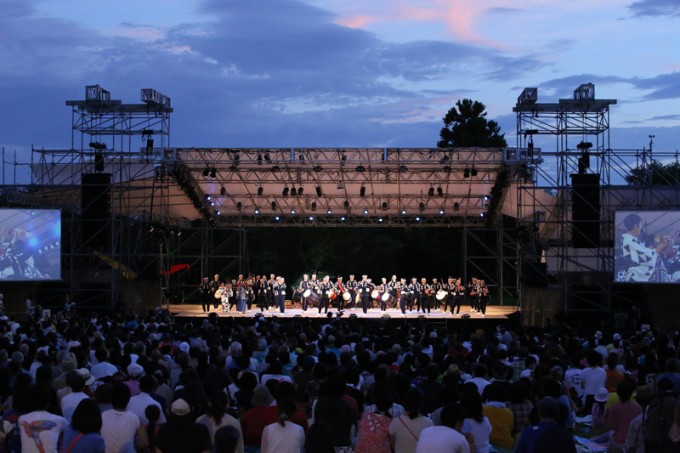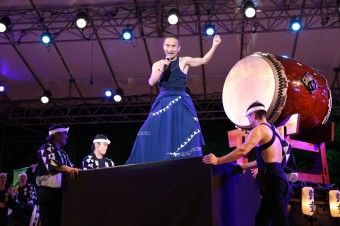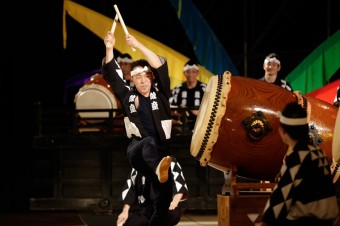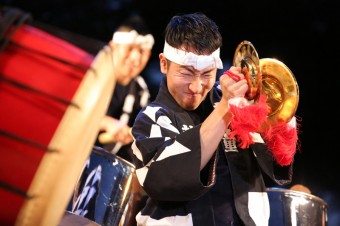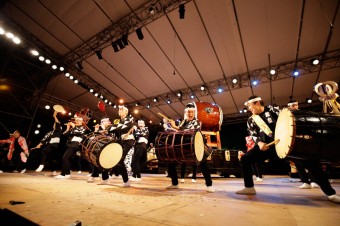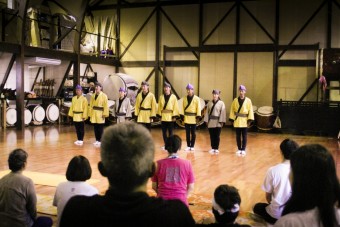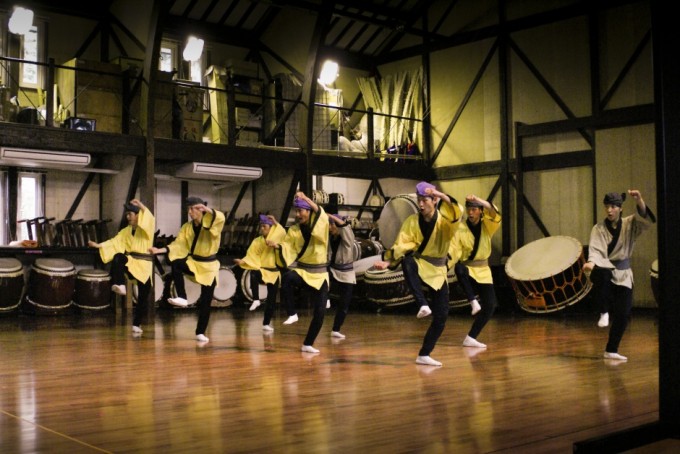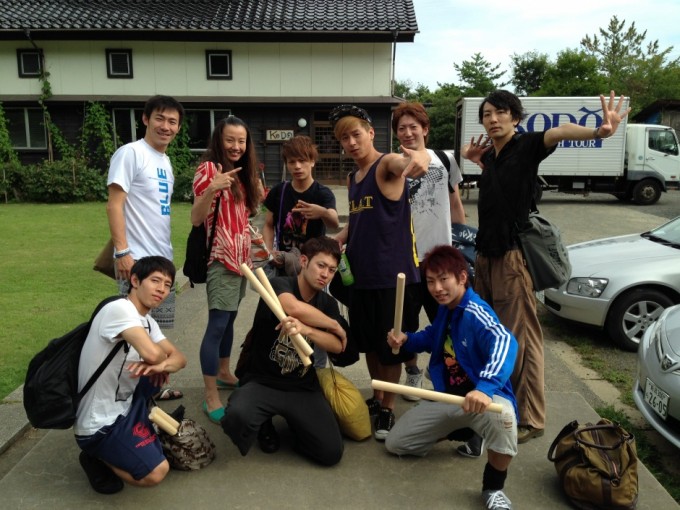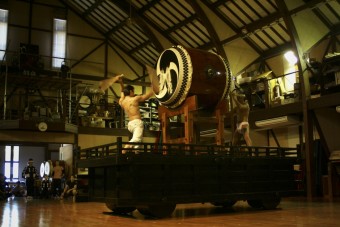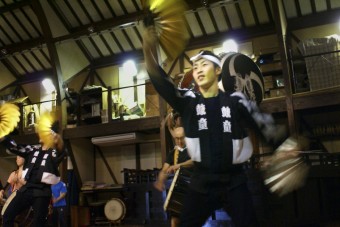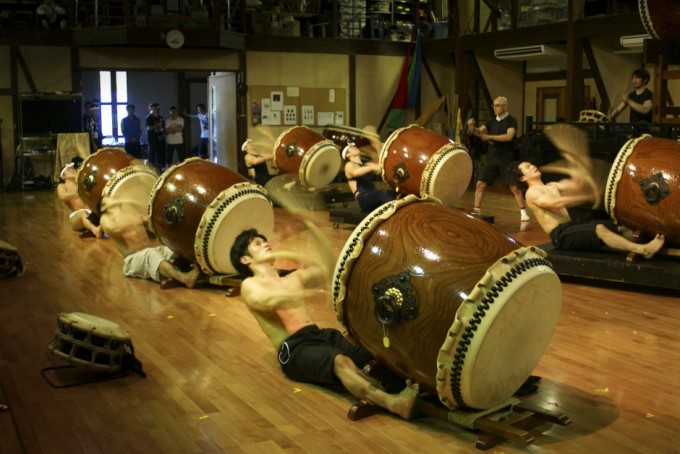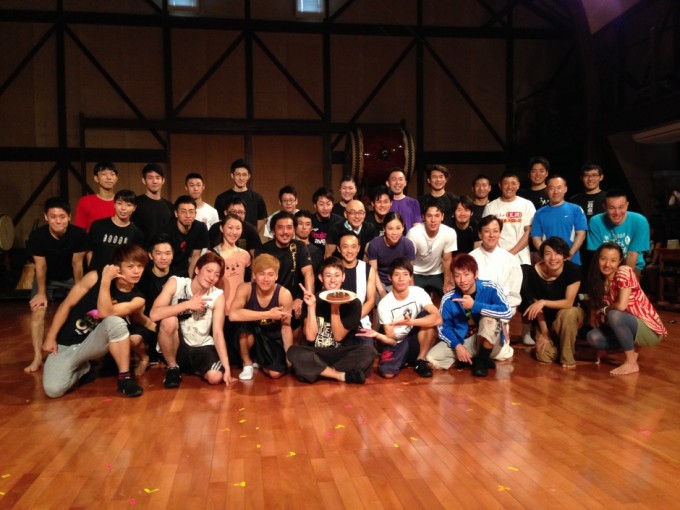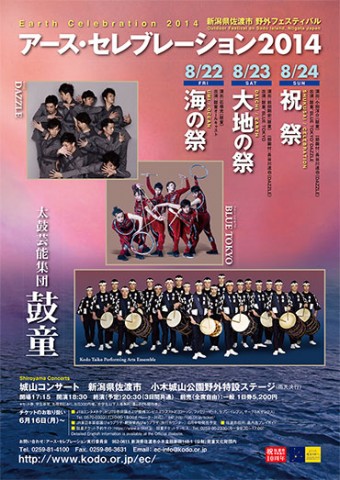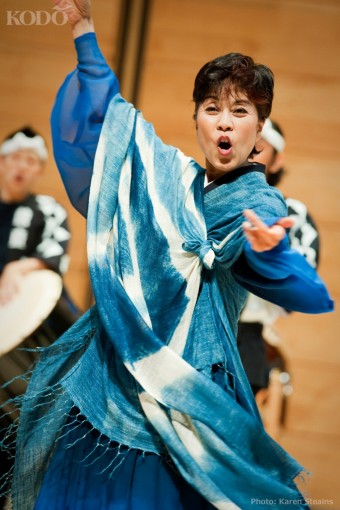Tag ‘Sado Island’
“Kodo Apprentices in Fall: Striving for a Place on Stage” by Tomohiro Mitome
This is Tomohiro Mitome, leader of taiko performing arts ensemble Kodo.
Now it is October and it has started to get chilly here on Sado Island.
“Kodo One Earth Tour: Mystery” and the “School Workshop Performance” tour are currently traveling around Japan. Some of you may have seen these performances already or will see one or both of them during these tours. Personally, I performed in the recent “Kodo Special Performances on Sado Island 2014: Autumn” series. Thank you very much to everyone who came along.
This month, I would like to talk about the apprentices studying at Kodo Apprentice Centre in hopes of becoming a member of the Kodo ensemble.
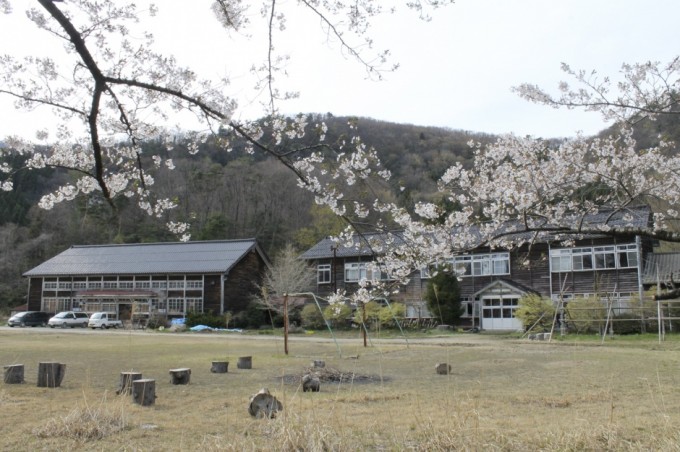
Kodo Apprentice Centre in Spring
To become a Kodo performer, first you need to complete a two-year apprenticeship at the Kodo Apprentice Centre (which includes passing selection to advance to the second year), and then on completion, you have to pass a final selection to join the Kodo ensemble. Those selected become “junior members” for approximately one year, during which they gain experience on stage and at a range of venues. After this probationary period, there is a further selection stage, which if they pass, they are offered a position as fully-fledged Kodo members.
At the Apprentice Centre, the apprentices get up at 5:00am in summer and 5:30am in winter, carry out cleaning duties, followed by stretching exercises and fitness training. After breakfast, they prepare the instruments required for the day’s practise and do warm-up exercises, then commence their morning practice. After lunch, they have afternoon practice, then after dinner, they practice either together or individually. They go to bed at 10:00pm in summer and 10:30pm in winter. This is their typical daily schedule. Sometimes, they come to Kodo Village, which is 40km away, to practice and do various tasks. On these days, they prepare a packed lunch to cut down on their meal time to accommodate the travel time.
At the Centre, the apprentices need to concentrate on the goal they are working towards, so we think they do not need the distraction of mobile phones and other electronic devices. Direct communication and connecting with people is a fundamental skill that should not rely on texting, email or the internet. Communication without email and texting is similar to the communication we need to have on stage. So that is why mobile phones and internet capable devices of any kind are prohibited during the apprenticeship. The apprentices are very busy practising everyday, except on their one day-off a week, and everyday they feel like they need more time to do everything they need to do. This means that even those of them who previously couldn’t live without mobile phones and computers easily get used to spending their time without them once they enter our intensive apprenticeship programme.
The first year apprentices started the programme in April, and now that about half a year has passed, at last they have gotten used to their new lifestyle and become “apprentice-like” to us. Currently, they are practising Yatai-bayashi and Miyake, which are both representative pieces of the Kodo repertoire, and they are getting to the stage where they can perform these pieces in full. As they work on their basic training, they also have been building up their physical and mental strength.
Basic training means repetition, and while it may not be interesting for them, this is a very important practice period to form their own individual base. If you don’t have solid foundations, when you try to build technique upon that base, it will just crumble away.
For example, the apprentices practise playing Yatai-bayashi for a long time, non-stop, because this piece requires physical strength to play in its entirety. If they don’t have enough power, the rhythm will become out of time, the sound will become weak, and it will be a really poor performance of the piece.
Now, it is very important for the first-year apprentices to do practise that will improve their physical strength, so they make themselves much stronger as they learn pieces and do their basic training repetitively. If you practise properly over and over, then technique will follow.
Meanwhile, the second-year apprentices are maintaining good physical strength, so now during their practice, we are helping them to improve their technique and instead of doing their best individually, we are instructing them to perform together as one powerful ensemble. We spend a lot of time teaching them in detail about making use of power, accents, and nuance in their playing. A good ensemble is created by each performer’s own skills.
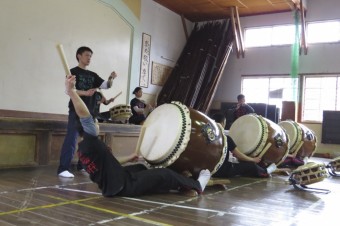
Only three months remain for second-year apprentices.
For them, each day is more important than ever before as they work towards their final recital in December, though there are also many fall events and harvest activities for them to fit in around concentrating on their practice. They all want to become Kodo members, so I hope that they will all come together as a team and do their best, without any regrets.
The first-year apprentices will also face selection to become second-year apprentices around the same time, so all the apprentices are nervous going into the three months ahead.
In Japan, there is a saying that it is not easy to improve one’s “mentality, technique and body.” I would like them to remember their hopes at the time when they first arrived at the Apprentice Centre, to imagine themselves standing on the Kodo stage, and to do their very best.
First Intake: Applications must arrive by Nov. 18 (Tue), 2014
*A limited second intake may be offered after the first intake.
“Valuable Lessons Performers Learn by Making Equipment” by Tomohiro Mitome
Sep. 1, 2014
This is Tomohiro Mitome, leader of taiko performing arts ensemble Kodo.
It is now September and little by little we can feel hints of autumn in the air. Actually, each year when the Ogi area falls quiet after the lively summer festivals, “Earth Celebration” and “Ogi Matsuri,” this calm feels like autumn has arrived all of a sudden.
This month, I would like to talk about my thoughts on making taiko drumsticks (bachi) and equipment.
I am constantly asked by taiko players, “Do you make your own drumsticks?” While it’s not every single pair, I do generally make my own drumsticks myself. This is connected to one of the core elements of Kodo’s Mission Statement: “Creating.”
When you become an apprentice and enter the Kodo Apprentice Centre, first you make your own chopsticks, then you make your own drumsticks. For the drumsticks, you use a saw to cut a square piece of timber to the right length, then using a plane you whittle the wood from a square piece into round sticks.
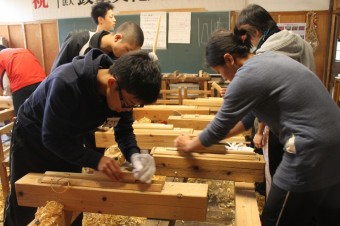
At first, you can’t make them well, but no matter how bumpy or oval your drumsticks are, they are filled with your blood, sweat and tears and you’ll be fond of them. And, it is a really huge shock when one of those drumsticks breaks. We really value them, so much so that we all keep our broken drumsticks for a special send-off, in the form of a lunar new year’s bonfire ritual each January.
Each pair of drumsticks is made from the same piece of wood, and if the sticks aren’t almost the same weight, the tone of the drum beats won’t be the same from your left and right hand. We are particular about our sound, so making drumsticks is very important to us.
In other words, for us, making drumsticks = making sound.
“Ogi Matsuri!” by Mitsuru Ishizuka
Aug. 29 Ogi Matsuri Daiko
Every year after Earth Celebration, the local festival “Ogi Matsuri” winds up the summer season.
During the festival, the Kodo members and apprentices take part by pulling a taiko cart around the streets of Ogi, going from house to house to play taiko as a sign of our appreciation to the townsfolk who look after us all year long.
Since I left the Kodo Village dormitory to live in Ogi, every year the Kodo cart also stops by my house to play taiko. As the thunderous roar of Kodo’s taiko gets closer and closer to my house, it makes my heart beat louder, and it’s a bit heartstopping, too… our sound certainly packs a punch!
In any case, our summer ended well again this year, thanks to everyone in Ogi. THANK YOU!!!
“Farewell Taiko” by Kenta Nakagome
Farewell Taiko on Aug. 25
Thank you very much for coming to Earth Celebration 2014. We had three days of feel-good performances surrounded by wonderful nature here on Sado Island.
We all went to the port to see the first ferry off after EC with heartfelt Okuri Daiko (“Farewell Taiko”), sincerely hoping to see you all again next year!
See you all again!
Photos: Mizuho Hasegawa
Thank You for Coming to Earth Celebration 2014!
Earth Celebration 2014
We would like to thank you for joining us for Earth Celebration 2014!
Next year, Earth Celebration will be held from Aug. 21 (Fri) through Aug. 23 (Sun). Further details will be announced in May 2015. We hope to see you all here again next summer on Sado Island!
There is an online EC questionnaire form on the official EC website. We would really appreciate your feedback on the festival this year. Thank you in advance!
Earth Celebration | http://www.kodo.or.jp/ec/en
Photos from EC 2014 Shiroyama Concert “UMI / OCEAN” on Aug. 22, 2014. (Photos: Maiko Miyagawa, Takashi Okamoto)
“Kodo Apprentice Recital: Okinawan Dance ‘Muribushi'” by Michiko Chida
Aug. 1, 2014
Kodo Apprentice Recital: Okinawan Dance Muribushi
The 2nd year apprentices spent one month learning Okinawan dance Muribushi, during this hot summer season. Today, they performed it for all the Kodo members and staff.
Okinawan dance expert Mitsue Kinjo has been teaching our apprentices for the last twenty years. By learning this unique, traditional Okinawan dance style, the apprentices are taught a fundamental attitude towards learning things. This is a timeless lesson.
“When you aim to create something new, first you have to take something in and absorb it within yourself. Then, something will be created from that. A new creation will come from something that takes root inside you and breathes. It is not something that you try to show or make decorative.”
Mitsue works hard with apprentices, actually, even harder than the apprentices, using her body and voice to passionately show and convey to them the importance of creating your own core.
I am sure that when the Kodo members, and the staff who were formerly apprentices, watch this annual recital that are reminded of their own time practicing as apprentices, frantically trying to use their bodies and minds well.
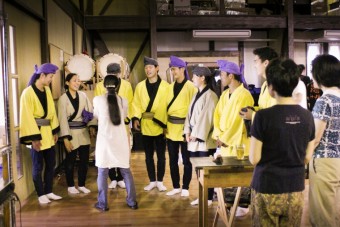
So, how were they today?
“Your hearts were all together, as one. You really did your best.”
After gruelling practices, Mitsue’s warm words echoed in the apprentices’ hearts. No one was selfish at all, and as individuals they all pulled together to perform together, which created such great power. Maybe today they understood the true meaning of Muribushi at last, which translates as “a group of stars.”
“BLUE TOKYO” Has Arrived!
Aug. 19, 2014
Today, Earth Celebration 2014 “Shiroyama Concert” guest artist BLUE TOKYO and Mr Hasegawa from DAZZLE arrived on Sado Island and came to Kodo Village.
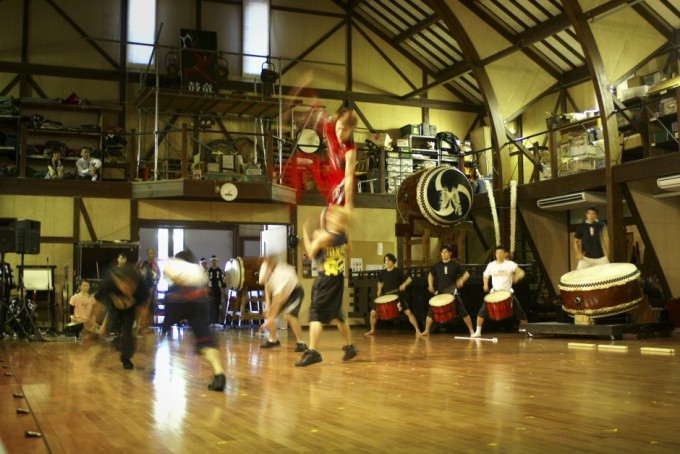
And we got straight into rehearsals with them! It is going to be such a powerful performance.
The Kodo members are putting their hearts right into it, too!
Today it was BLUE TOKYO member Satoshi Ishizuka’s birthday! We wished him a very happy birthday!
“‘Yamazu Megurumo’ Concerts” by Yoko Fujimoto
All the Kodo members are working very hard, preparing for Earth Celebration. So am I! I’m in the middle of rehearsals for the opening night performance!
But, I would like to take a moment now to let you all know about my upcoming activities.
“Yamazu Megurumo” Concerts
I am going to perform with local bluegrass musicians on Sado Island for the first time.
Their amazing sound and technique will create a new world for all the pieces on my CD “Yamazu Megurumo.” As the vocals entwine with their music, the songs will take on different colors and expressions. I will also add some other folksongs to the set list and I am going to have a really good time with their music!
Also, this will be the first time for me to have a chorus accompaniment at one of my concerts. I am planning a fun performance for you all, with lots of “firsts” and things I like, so please come along!
Yoko Fujimoto “Yamazu Megurumo” Concerts
Sep. 20 (Sat), 2014 Hotel Azuma, Aikawa, Sado Island, Niigata
Sep. 23 (Tue), 2014 Cafe Hitoha, Sawata, Sado Island, Niigata
http://www.kodo.or.jp/news/20140920yoko_en.html
Kodo Online Store [CD] Yoko Fujimoto “Yamazu Megurumo”
“Prayer for Safety at Kisaki Shrine” by EC Publicity
Earth Celebration is coming up this weekend. Today, all of the performers and staff gathered at Kisaki Shrine to pray together for a safe festival.
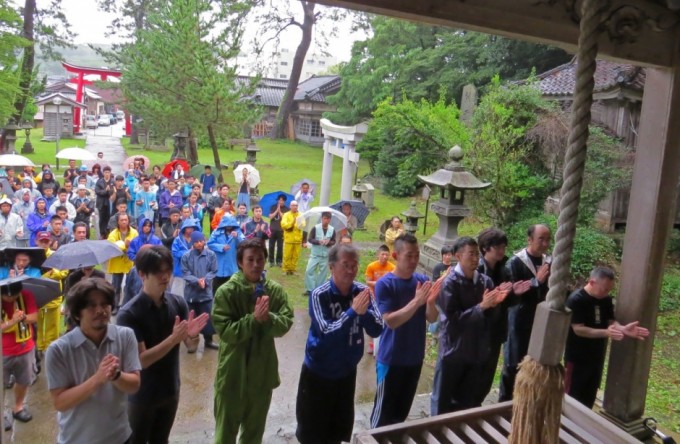
We wish you all a safe journey to join us here on Sado Island, too!
We really hope that everyone who gathers for Earth Celebration will have a wonderful time with us.
“The Fukaura Schoolhouse” by Johnny Wales
Fukaura Gakusha – The Fukaura Schoolhouse
by Johnny Wales
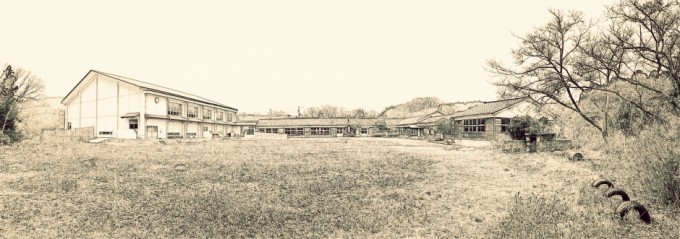
Welcome to Fukaura Gakusha (Fukaura Schoolhouse)
Not far from Kodo Village and perched high on the same ridge on Sado’s southern-most coast is the Fukaura Schoolhouse. This is where the first generation of Kodo members’ own children went to elementary and middle school, so it holds a special place in our hearts. Sadly, three years ago – as in so many other places in the Japanese countryside – it closed due to lack of young people to fill up its desks. Just a 15-minute walk down the road from the Sado Island Taiko Centre, a 15-minute drive from the port of Ogi, and 20 minutes to Sado’s largest sandy beach, this nostalgic wooden school in a grassy field is setting out on its second life. It will serve as a base for people coming to breath the air and experience first-hand what has made this magical island such a source of inspiration to us these forty years. Kodo’s dream has long been to not only bring the sights and sounds of Japan to the world but also to bring the world to Sado. We also want to do our part in giving back to the people of the island. Our busy lives here and on tour have meant that we haven’t been able to open Kodo Village to visitors except on special occasions. For those wanting to experience taiko here on the island the Sado Taiko Centre was built next to Kodo Village in 2007. There are no facilities for staying over though, so people were on their own when looking for a convenient place to stay. They say ‘When one door closes, another opens’, and so it is with the old Fukaura Schoolhouse. With the installation of modern bathrooms and conversion of some of the classrooms into dormitories with either tatami mats or bunk beds, we now have comfortable, if simple accommodations at a reasonable price for groups of up to 40 people, and it’s right down the road. Three meals a day are available featuring delicious home-made, seasonal, locally-sourced cuisine. A vegetarian or special dietary plan can also be arranged.

Inside Fukaura Gakusha (Fukaura Schoolhouse)
So if your group wants to experience the best of rural Japan – and while you are at it, drum your hearts out – here is the place to do it. Whether you are an experienced taiko group, have never even seen a Japanese drum and want to use a workshop as a team-building exercise, or you have a group of both veterans and beginners, one of Kodo’s veteran players can tailor a workshop to meet your needs.




